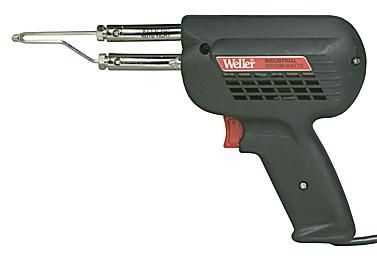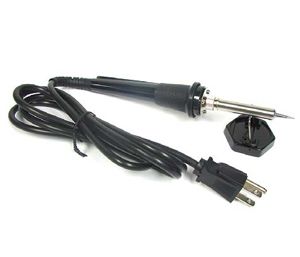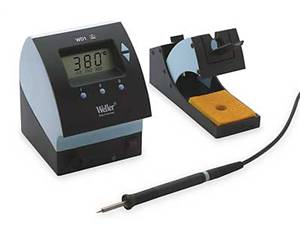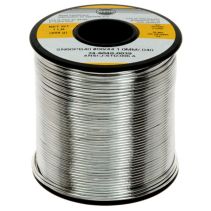How to Solder - Through-hole Soldering
Soldering is defined as "the joining of metals by a fusion of alloys which have relatively low melting points". In other words, you use a metal that has a low melting point to adhere the surfaces to be soldered together. Consider that soldering is more like gluing with molten metal, unlike welding where the base metals are actually melted and combined. Soldering is also a must have skill for all sorts of electrical and electronics work. It is also a skill that must be taught correctly and developed with practice.
The Soldering Iron/Gun
The first thing you will need is a soldering iron, which is the heat source used to melt solder. Irons of the 15W to 30W range are good for most electronics/printed circuit board work. Anything higher in wattage and you risk damaging either the component or the board. If you intend to solder heavy components and thick wire, then you will want to invest in an iron of higher wattage (40W and above) or one of the large soldering guns. The main difference between an iron and a gun is that an iron is pencil shaped and designed with a pinpoint heat source for precise work, while a gun is in a familiar gun shape with a large high wattage tip heated by flowing electrical current directly through it.
  |
For hobbyist electronics use, a soldering iron is generally the tool of choice as its small tip and low heat capacity is suited for printed circuit board work (such as assembling kits). A soldering gun is generally used in heavy duty soldering such as joining heavy gauge wires, soldering brackets to a chassis or stained glass work.
 You should choose a soldering iron with a 3-pronged grounding plug. The ground will help prevent stray voltage from collecting at the soldering tip and potentially damaging sensitive (such as CMOS) components. By their nature, soldering guns are quite "dirty" in this respect as the heat is generated by shorting a current (often AC) through the tip made of formed wire. Guns will have much less use in hobbyist electronics so if you have only one tool choice, an iron is what you want. For a beginner, a 15W to 30W range is the best but be aware that at the 15W end of that range, you may not have enough power to join wires or larger components. As your skill increases, a 40W iron is an excellent choice as it has the capacity for slightly larger jobs and makes joints very quickly. Be aware that it is often best to use a more powerful iron so that you don't need to spend a lot of time heating the joint, which can damage components.
You should choose a soldering iron with a 3-pronged grounding plug. The ground will help prevent stray voltage from collecting at the soldering tip and potentially damaging sensitive (such as CMOS) components. By their nature, soldering guns are quite "dirty" in this respect as the heat is generated by shorting a current (often AC) through the tip made of formed wire. Guns will have much less use in hobbyist electronics so if you have only one tool choice, an iron is what you want. For a beginner, a 15W to 30W range is the best but be aware that at the 15W end of that range, you may not have enough power to join wires or larger components. As your skill increases, a 40W iron is an excellent choice as it has the capacity for slightly larger jobs and makes joints very quickly. Be aware that it is often best to use a more powerful iron so that you don't need to spend a lot of time heating the joint, which can damage components.
80W temperature controlled soldering station A variation of the basic gun or iron is the soldering station, where the soldering instrument is attached to a variable power supply. A soldering station can precisely control the temperature of the soldering tip unlike a standard gun or iron where the tip temperature will increase when idle and decrease when applying heat to a joint. However, the price of a soldering station is often ten to one hundred times the cost of a basic iron and thus really isn't an option for the hobby market. But if you plan to do very precise work, such as surface mount, or spend 8 hours a day behind a soldering iron, then you should consider a soldering station.
The rest of this document will assume that you are using a soldering iron as that is what the majority of electronics work requires. The techniques for using a soldering gun are basically the same with the only difference being that heat is only generated when the trigger is pressed.
Solder
 The choice of solder is also important. There several kinds of solder available but only a few are suitable for electronics work. Most importantly, you will only use rosin core solder. Acid core solder is common in hardware stores and home improvement stores, but meant for soldering copper plumbing pipes and not electronic circuits. If acid core solder is used on electronics, the acid will destroy the traces on the printed circuit board and erode the component leads. It can also form a conductive layer leading to shorts.
The choice of solder is also important. There several kinds of solder available but only a few are suitable for electronics work. Most importantly, you will only use rosin core solder. Acid core solder is common in hardware stores and home improvement stores, but meant for soldering copper plumbing pipes and not electronic circuits. If acid core solder is used on electronics, the acid will destroy the traces on the printed circuit board and erode the component leads. It can also form a conductive layer leading to shorts.
Kester For most printed circuit board work, a solder with a diameter of 0.75MM to 1.0MM is desirable. Thicker solder may be used and will allow you to solder larger joints more quickly, but will make soldering small joints difficult and increase the likelihood of creating solder bridges between closely spaced PCB pads. An alloy of 60/40 (60% tin, 40% lead) is used for most electronics work. These days, several lead-free solders are available as well. Kester "44" Rosin Core solder has been a staple of electronics for many years and continues to be available. It is available in several diameters and has a non-corrosive flux.
Large joints, such as soldering a bracket to a chassis using a high wattage soldering gun, will require a separate application of brush on flux and a thick diameter solder of several millimeters.
Remember that when soldering, the flux in the solder will release fumes as it is heated. These fumes are harmful to your eyes and lungs. Therefore, always work in a well ventilated area and avoid breathing the smoke created. Hot solder is also dangerous. It is surprisingly easy to splash hot solder onto yourself, which is a thoroughly unpleasant experience. Eye protection is also advised.
cool :) thanks for the information ! keep it up :)
ReplyDeletevery informative :)
ReplyDeleteMay video po ba nyan?
ReplyDeletewait for my update :) i'll be providing a video tutorial for my next post :)
Deleteang cute ng font ng blog mo :) buti pa blog mo cute :p
ReplyDeletethis blog will not only help students but also those who want to learn about soldering :D
ReplyDeletewow.. JUST WOW!. thanks sa info!. may maituturo na ko sa mga estudyante ko.. di na ko mahihirapang magsearch!. thanks ulit!
ReplyDeletethis blog will help first students na an major tlga ay electronics. Okay 'to pra sa basic electronics nila :))
ReplyDeleteexcellent support and clear instructions helped me complete the circuit board job I was doing.
ReplyDeleteso informative and i gain new ideas about it :)
ReplyDelete